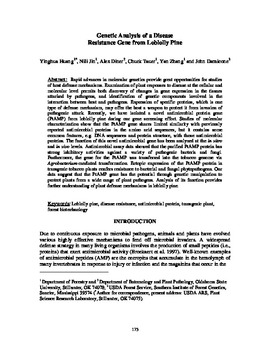| dc.contributor.author | Huang, Y. | |
| dc.contributor.author | Jin, N. | |
| dc.contributor.author | Diner, A. | |
| dc.contributor.author | Tauer, C. | |
| dc.contributor.author | Zhang, Y. | |
| dc.contributor.author | Damicone, J. | |
| dc.date.accessioned | 2016-04-25T19:36:03Z | |
| dc.date.available | 2016-04-25T19:36:03Z | |
| dc.date.issued | 2003 | |
| dc.identifier | oksd_sf27_p173.pdf | |
| dc.identifier.citation | Huang, Y., Jin, N., Diner, A., Tauer, C., Zhang, Y., & Damicone, J. (2003). "Genetic Analysis of a Disease Resistance Gene from Loblolly Pine." In 27th Southern Forest Tree Improvement Conference, Stillwater, OK | |
| dc.identifier.uri | https://hdl.handle.net/11244/33686 | |
| dc.description.abstract | Rapid advances in molecular genetics provide great opportunities for studies of host defense mechanisms. Examination of plant responses to disease at the cellular and molecular level permits both discovery of changes in gene expression in the tissues attacked by pathogens, and identification of genetic components involved in the interaction between host and pathogens. Expression of specific proteins, which is one type of defense mechanism, may offer the host a weapon to protect it from invasion of pathogenic attack. Recently, we have isolated a novel antimicrobial protein gene (PtAMP) from loblolly pine during our gene screening effort. Studies of molecular characterization show that the PtAMP gene shares limited similarity with previously reported antimicrobial proteins in the amino acid sequences, but it contains some common features, e.g. DNA sequences and protein structure, with those antimicrobial proteins. The function of this novel antimicrobial gene has been analyzed at the in vitro and in vivo levels. Antimicrobial assay data showed that the purified PtAMP protein has strong inhibitory activities against a variety of pathogenic bacteria and fungi. Furthermore, the gene for the PtAMP was transferred into the tobacco genome via Agrobacterium-mediated transformation. Ectopic expression of the PtAMP protein in transgenic tobacco plants confers resistance to bacterial and fungal phytopathogens. Our data suggest that the PtAMP gene has the potential through genetic manipulation to protect plants from a wide range of plant pathogens. Analysis of its function provides further understanding of plant defense mechanisms in loblolly pine. | |
| dc.format | application/pdf | |
| dc.language | en_US | |
| dc.relation.ispartofseries | Sponsored publication . . . of the Southern Forest Tree Improvement Committee ; no. 49 | |
| dc.rights | This paper is made available through open access and the auspices of the fair use doctrine for scholarly, educational and research purposes while recognizing the publisher already offers a free online version. The OSU Library�s intent is to offer access and preserve publications involving its faculty contributions. Contact the Digital Resources and Discovery Services at lib-dls@okstate.edu or 405-744-9161 for the permission policy on the use, reproduction or distribution of this material. | |
| dc.source | Proceedings of the 27th Southern Forest Tree Improvement Conference, volume 27, 2003. Editor, Craig R. McKinley. | |
| dc.title | Genetic Analysis of a Disease Resistance Gene from Loblolly Pine | |
| dc.type | text | |
| osu.filename | oksd_sf27_p173.pdf | |
| dc.type.genre | Conference proceedings | |
| dc.subject.keywords | loblolly pine | |
| dc.subject.keywords | disease resistance | |
| dc.subject.keywords | antimicrobial protein | |
| dc.subject.keywords | transgenic plant | |
| dc.subject.keywords | forest biotechnology | |
| osu.contributor.author | Tauer, Charles G. | |
| osu.contributor.author | Huang, Yinghua | |
| dc.description.scopeandcontents | Papers and abstracts from the 27th Southern Forest Tree Improvement Conference held at Oklahoma State University in Stillwater, Oklahoma on June 24-27, 2003. | |
